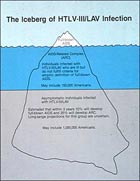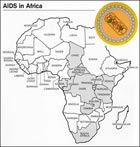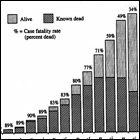|
|
 |
|
Tip of the Iceberg
In the early 1980s, the era of infectious diseases was over, many people
believed. Hadn’t modern medicine conquered scourges such as tuberculosis
and polio with antibiotics and vaccines? Legionnaire’s disease and
toxic shock syndrome caused brief scares in the 1970s, but they were quickly
brought under control. Ironically, just as the awareness of AIDS was dawning,
Dr. Richard Krause, then director of the National Institute of Allergy
and Infectious Diseases, challenged the fallacy of this thinking in his
book titled The Restless Tide: The Persistent Challenge of the Microbial
World. By the summer of 1982, scientists had convincing evidence that
AIDS must be caused by a blood-borne and sexually transmitted virus. That
meant it affected people’s most private experiences. By the fall
of 1984, not only had a retrovirus been identified as the cause of AIDS,
it also had been shown to have properties that would make it very difficult,
if not impossible, to make a conventional vaccine against AIDS. As reports
of AIDS also arrived from other parts of the world–Africa, Haiti,
Europe, and Asia–Dr. Thomas C. Quinn of NIAID and others visited
these areas and began conducting research. They returned to the United
States sounding warning bells of what the epidemic could become. Meanwhile,
physicians were learning that the period between infection and the onset
of AIDS symptoms could be 10 years or more. The accumulating evidence
was sobering: all of it pointed to the formation of a gigantic iceberg
of global disease, only the tip of which was then visible.
The audio samples below require the Real Audio Player. To download this
program, please go to: http://www.real.com/
 Over 600 patients have now been reported as having this
disease, and the disease is called an epidemic because it's occurring
at a slightly increased frequency in recent weeks. Over 600 patients have now been reported as having this
disease, and the disease is called an epidemic because it's occurring
at a slightly increased frequency in recent weeks.
- Dr. Kenneth Sell, 1982 radio interview
Download Audio Sample
| Transcript |
 I remember…doing a rough mental calculation of the number of
gays in the country and the percentage who were likely to be HIV-infected,
and estimating that there were half a million to a million people
infected with this lethal virus who did not know it. I remember…doing a rough mental calculation of the number of
gays in the country and the percentage who were likely to be HIV-infected,
and estimating that there were half a million to a million people
infected with this lethal virus who did not know it.
-
Dr. Robert Yarchoan
Download Audio Sample |Transcript |
 I felt this was not just a gay disease, and I doubted that this was
dirty needles. But the only way we were ever going to find out was
to go to Africa or go back to Haiti and set up good prospective long-term
epidemiologic studies. I felt this was not just a gay disease, and I doubted that this was
dirty needles. But the only way we were ever going to find out was
to go to Africa or go back to Haiti and set up good prospective long-term
epidemiologic studies.
- Dr. Thomas C. Quinn
Download Audio
Sample | Transcript |
 So my paper about heterosexual spread in STD clinics in the United
States…came out about the same time [1988] that Cosmopolitan came out with their front cover saying, “Women, you do not need
to worry. You can’t get AIDS. So my paper about heterosexual spread in STD clinics in the United
States…came out about the same time [1988] that Cosmopolitan came out with their front cover saying, “Women, you do not need
to worry. You can’t get AIDS.
- Dr. Thomas
C. Quinn
Download
Audio Sample | Transcript |
 Here we are with AIDS and people still have not had the foresight
to understand that this can happen again. We are not even half over
with this yet. Here we are with AIDS and people still have not had the foresight
to understand that this can happen again. We are not even half over
with this yet.
- Dr. Anthony S. Fauci
Download
Audio Sample | Transcript |
Back To Top | Photography
Credits
|
|
 |
| The NAMES Project AIDS quilt, representing
people who have died of AIDS, in front of the Washington Monument |
| |
 |
| Because AIDS symptoms can take 10 years to develop,
only a small fraction of the epidemic was visible in 1985 |
| |
 |
| As the epidemic expanded, a map showed
the first African countries affected by HIV/AIDS. |
| |
 |
| Graph shows steady climb in AIDS cases between
1981 and 1987. In late 1985, the death rate began to slow but remained
high. |
|
 |

